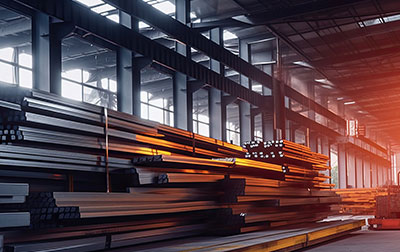Iron ore: The decarbonization transformation
 The industry has made great progress in reducing Scope 1 (direct) and 2 (indirect) emissions from resources it controls or uses, such as vehicles, electricity, heating, and cooling. However, it is still lagging on Scope 3 emissions, which include all other indirect emissions, upstream and downstream, that occur in the value chain.
The industry has made great progress in reducing Scope 1 (direct) and 2 (indirect) emissions from resources it controls or uses, such as vehicles, electricity, heating, and cooling. However, it is still lagging on Scope 3 emissions, which include all other indirect emissions, upstream and downstream, that occur in the value chain.
There is no one-size-fits-all solution to addressing the challenges of producing lower-carbon iron ore and steel. There is currently a massive shift in technology occurring in the steel industry. The question is: What will happen to the industry when the dominant steelmaking technology no longer includes carbon-intensive blast furnaces? Strategies differ depending on a variety of factors, including location, type of ore, and available energy sources. However, a common thread is the need for the industry to innovate and adapt continuously.
North America’s approach
The North American region produced about 104 million tons of iron ore in 2023, with 60 million tons from Canada and 44 million tons from the United States. The ore in North America, primarily hematite and magnetite, is considered lower grade but responds well to beneficiation, a process that improves the quality of iron ore by removing impurities.
The main advantage the US has is its ore’s liberation capacity, meaning it can be easily separated during processing but still needs to be beneficiated.
Beneficiation processes produce high-grade ore that can be used as feedstock, usually in the form of pellets or briquettes, in the traditional direct reduction (DR) process. This results in iron and steel with significantly less carbon emissions. However, this process requires significant resources, including water, energy, and consumables, and generates tailings that need to be managed. The average recovery yield is typically 78-82% total ferrous content while some of the finer iron is lost in the tailings waste.
In Canada, high-purity iron ore has been recognized as a critical mineral, particularly in the Labrador Trough. This recognition has fostered collaboration between operators, government, and other stakeholders to support the decarbonization of the iron ore and steel industries. Labrador Trough’s high-quality iron ore makes it an ideal candidate for producing DR-grade iron ore, which is essential for greener steel production using existing technology.
South America’s focus
In South America, Brazil’s iron ore industry faces similar challenges to those in other regions, including the need to reduce emissions and improve efficiency. Brazil’s orebody has high ferrous content with very low detrimental impurities. This offers a great economic advantage in terms of low-cost production of iron ore and steel. In 2024, Brazil’s overall iron production was approximately 440 million tonnes. However, DR-grade pellets, which are in great demand for their use in environmentally friendly steelmaking, accounted for only 10 to 15% of that production.
Brazil, therefore, is increasingly focusing on producing high-quality DR-grade pellets to tap into new markets and boost exports by adding beneficiation capacity as the ROM grade/quality is getting generally lower. This shift aims to meet the growing demand for these pellets and leverage their economic and environmental benefits.
Australia’s iron ore landscape
Australia is the largest exporter of iron ore in the world, exporting roughly one billion tonnes per annum, primarily goethite and hematite from the Pilbara region. The ore is high in gangue (alumina and silica) and ideally suited for the blast furnace route. Because of the unique crystalline structure of the ore, there is no current commercially viable beneficiation route available to reduce the gangue sufficiently as required for higher-grade ore markets or processes.
The Pilbara region is home to some of the world’s largest iron ore mines. It accounts for more than 50% of global production. The shipping routes from Australian to Asian are perfectly suited for accommodating all the blast furnace production between the continents. Australian iron ore producers are working closely with steel producers in Asia to support the transition to greener, carbon-free technology. Obviously, as with any producer, it’s important to keep pace with the market. The Pilbara producers are very aware of this and proactively strive to support the transition to carbon-free technology. This includes investing in developing the direct reduced iron and electric smelting furnace (DRI-ESF) route for the higher-gangue Pilbara ore.
Interestingly, Australia has extensive magnetite reserves, but because goethite is so easy to process—and there’s such a large market for it—there is no pressing need to invest in the expansion of magnetite. That said, the small amount of magnetite that is mined, both for local consumption and export, has been increasing as global demand for more DR-grade pellets expands.
Exploring alternative energy sources
Alternative energy sources like pyrolytic oil and plasma torches are being considered to support greener iron ore production. Small modular reactors (SMRs) are also seen as a potential energy source. Despite the complexities involved in their implementation, SMRs could provide a reliable and low-carbon energy source for the iron ore industry.
The development of new process technologies and innovative solutions is crucial for the future of the iron ore industry. These advancements can help address the challenges of producing high-grade ore and support the decarbonization of the steel value chain. By investing in research and development, the industry can find new ways to improve efficiency and reduce environmental impact.
Partnering for success
Collaborating with a partner like Hatch can help clients in the iron ore industry succeed by providing innovative and sustainable solutions across the entire value chain, from mining and beneficiation to ore agglomeration. Our expertise in advanced technologies, operational efficiency, and environmental responsibility spans over six decades and ensures that clients can maximize production, reduce costs, and meet their sustainability goals.
From North America's beneficiation processes to Brazil’s focus on DR-grade pellets and Australia’s collaboration with Asian steel producers, the industry is making strides toward a more sustainable future. By embracing innovative technologies and alternative energy sources, the iron ore sector can continue to reduce emissions and improve efficiency.

Bruno Vartuli
Senior Metals Consultant Iron & Steel, Project Development

Stefanie Vo
Iron Ore Processing Specialist, Mineral Processing

Martin Dionne
Global Commodity Director, Iron Ore & Co, Project Development
